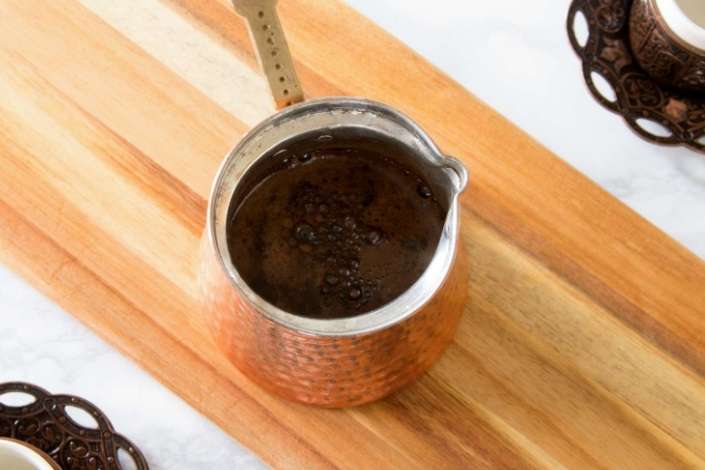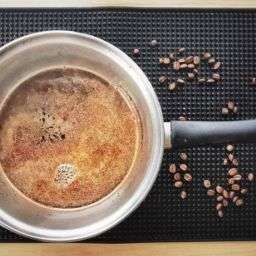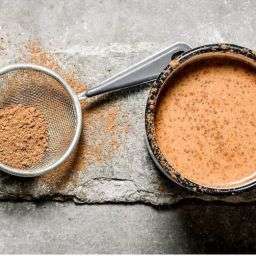
Brewing coffee using a Turkish coffee pot, known as a cezve or ibrik, is an art form steeped in history and tradition. Originating from the Middle East, this method has spread across the globe, celebrated for its unique taste and the ritualistic pleasure it brings to both the brewer and the drinker. The cezve is a small pot, traditionally made from copper or brass, with a long handle designed for brewing coffee over a stove.
The process involves finely ground coffee and water, often sweetened, brewed together to create a rich, frothy, and intensely flavored cup of coffee. This method’s historical roots run deep, tracing back to the Ottoman Empire, making it an integral part of Turkish cultural heritage and a beloved daily ritual for millions.
Key Takeaways
- The material of your Turkish coffee pot plays a crucial role in the brewing process. Copper pots, favored for their superior heat conductivity, ensure even heat distribution, resulting in a perfectly brewed coffee every time. However, alternatives like stainless steel, enamel, and even glass offer their unique advantages and aesthetics for the modern coffee enthusiast.
- Heat management is critical. The goal is to heat the coffee slowly, allowing flavors to develop fully without boiling over and ruining the precious foam that Turkish coffee is famous for. This foam is not just about looks; it’s a sign of a well-brewed coffee, capturing the essence and strength of the beans.
- Personalizing your brew with water-to-coffee ratios is part of the fun. Turkish coffee is versatile; whether you prefer your coffee strong and bold or slightly milder, adjusting the ratio of water to coffee allows you to tailor each cup to your liking. Experimentation is key, finding that perfect balance that suits your palate.
- Lastly, the significance of the foam on Turkish coffee cannot be overstated. It’s not just a mark of a skilled brewer; it’s a cherished part of the experience. The foam holds much of the aroma and flavor, making the first sip the most memorable. Achieving the perfect foam requires patience and practice but is well worth the effort for the unparalleled taste it provides.
Choosing Your Turkish Coffee Pot
When it comes to making Turkish coffee, the pot you choose isn’t just a tool; it’s a companion in your coffee brewing journey. Each material—copper, stainless steel, enamel, and glass—brings something unique to the table. Copper is the traditional favorite, praised for its excellent heat conductivity, which ensures even heating and a perfectly brewed pot every time. It’s not just about tradition; copper pots help in extracting the full flavor from your coffee grounds.
Stainless steel pots are lauded for their durability and ease of maintenance, making them a great choice for everyday use. Enamel pots offer a modern twist, combining durability with a touch of style. For those who love the aesthetic aspect of coffee brewing, glass pots allow you to watch your coffee as it brews, adding a visual element to the process.
When picking the size and design of your Turkish coffee pot, consider how much coffee you typically make. Sizes range widely, from single-serving pots to those capable of brewing coffee for a crowd. Think about your daily coffee routine—do you enjoy coffee solo, or do you often find yourself making coffee for family and friends? The answer will guide you to the perfect size. As for design, it’s a matter of personal preference, but ensure your pot has a handle that stays cool to prevent burns.
Ingredients and Ratios
The foundation of a great Turkish coffee lies in the balance of ingredients—water, coffee, and sugar. The traditional ratio is one to two heaping teaspoons of coffee per Turkish coffee cup (roughly 2 oz or 60 ml), with water filled to the brim of the cup. Sugar is added according to taste, ranging from none to very sweet, allowing you to customize the sweetness level of your brew.
Grind size and quality of coffee are crucial. The coffee should be ground to a fine powder, finer than what is used for espresso. This fine grind allows for maximum flavor extraction without over-extraction, which can lead to bitterness. Investing in high-quality, freshly roasted coffee beans and grinding them yourself just before brewing will make a significant difference in the taste of your coffee. The grind should be as uniform as possible to ensure even brewing and optimal flavor.
Brewing Process
Brewing Turkish coffee is a delightful process that combines art with tradition. Here’s how to achieve that perfect brew:
- Measure and Mix: Start by adding cold water to your cezve, using the cup you’ll serve the coffee in to measure the water. For each cup, add one to two heaping teaspoons of finely ground Turkish coffee. If you like your coffee sweet, add sugar at this stage. Give it a gentle stir to mix the ingredients.
- Heat Gently: Place the cezve on low heat. Patience is key here. The coffee needs to heat slowly to allow flavors to develop without boiling too quickly. This slow rise in temperature is crucial for foam formation.
- Watch the Foam: As the coffee heats, a dark foam will form. This is the heart of Turkish coffee. Just before it boils, spoon some of the foam into each cup. This ensures you keep that prized foam when serving.
- Final Brew: Allow the coffee to come to a gentle boil, then pour it over the foam in the cups, being careful not to disturb the foam too much. The coffee should have a rich, creamy layer on top, capturing the essence of the brew.
- Serve Immediately: Turkish coffee is best enjoyed fresh. Serve it as soon as it’s ready to capture the full flavor and aroma.
Serving Turkish Coffee
Traditional Practices: Serving Turkish coffee is about more than just the drink; it’s about hospitality. Traditionally, it’s served with water to cleanse the palate before enjoying the coffee. A sweet treat like Turkish delight accompanies the coffee, balancing its strong flavor. The foam is crucial, as it’s a sign of a well-made coffee, so make sure to distribute it evenly among the cups. After enjoying the coffee, some like to read the coffee grounds left in the cup, a fun tradition that adds to the experience.
Alternative Serving Suggestions: Not everyone has the same taste, and Turkish coffee is adaptable. For those who prefer a less traditional approach, consider serving it with other sweets or even pairing it with a small snack. If foam isn’t your thing, you can skip the spooning step, but remember, it’s the foam that holds much of the flavor and aroma.
FAQs
Why isn’t my Turkish coffee foaming? Foam formation is crucial in Turkish coffee, and several factors can affect it. The heat should be low and rising slowly—too high, and you’ll miss the foam. Also, ensure your coffee is fresh and finely ground. Stirring after it starts heating can also disrupt the foam, so avoid stirring once on the heat.
Why does my Turkish coffee taste bitter? Bitterness usually stems from overbrewing. Ensure your coffee doesn’t boil for too long; as soon as you see the foam rising, it’s time to remove it from the heat. The quality of your coffee beans and the fineness of the grind also play a significant role; fresher beans and a fine grind can help reduce bitterness.
Can I make Turkish coffee without an ibrik? Yes, you can use a small saucepan as an alternative. While the traditional method with an ibrik is preferred for its unique foam and flavor, using a saucepan can still yield a delicious cup. Just be mindful that the foam might not be as thick, and the coffee’s body could be slightly different.
Final Thoughts
Brewing Turkish coffee is an experience that marries the art of coffee making with the science of heat and flavor extraction. It’s a ritual that goes beyond simply making a cup of coffee—it’s about creating an experience that engages the senses, reflects culture, and brings people together.
The personal touch in choosing your beans, pot, and perfecting your brewing technique makes each cup a unique reflection of the brewer. Whether you’re a seasoned aficionado or a curious newcomer, the journey of making Turkish coffee offers a rich tapestry of flavors, traditions, and personal discoveries.








